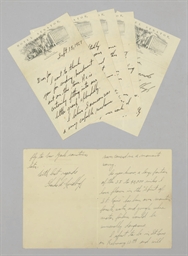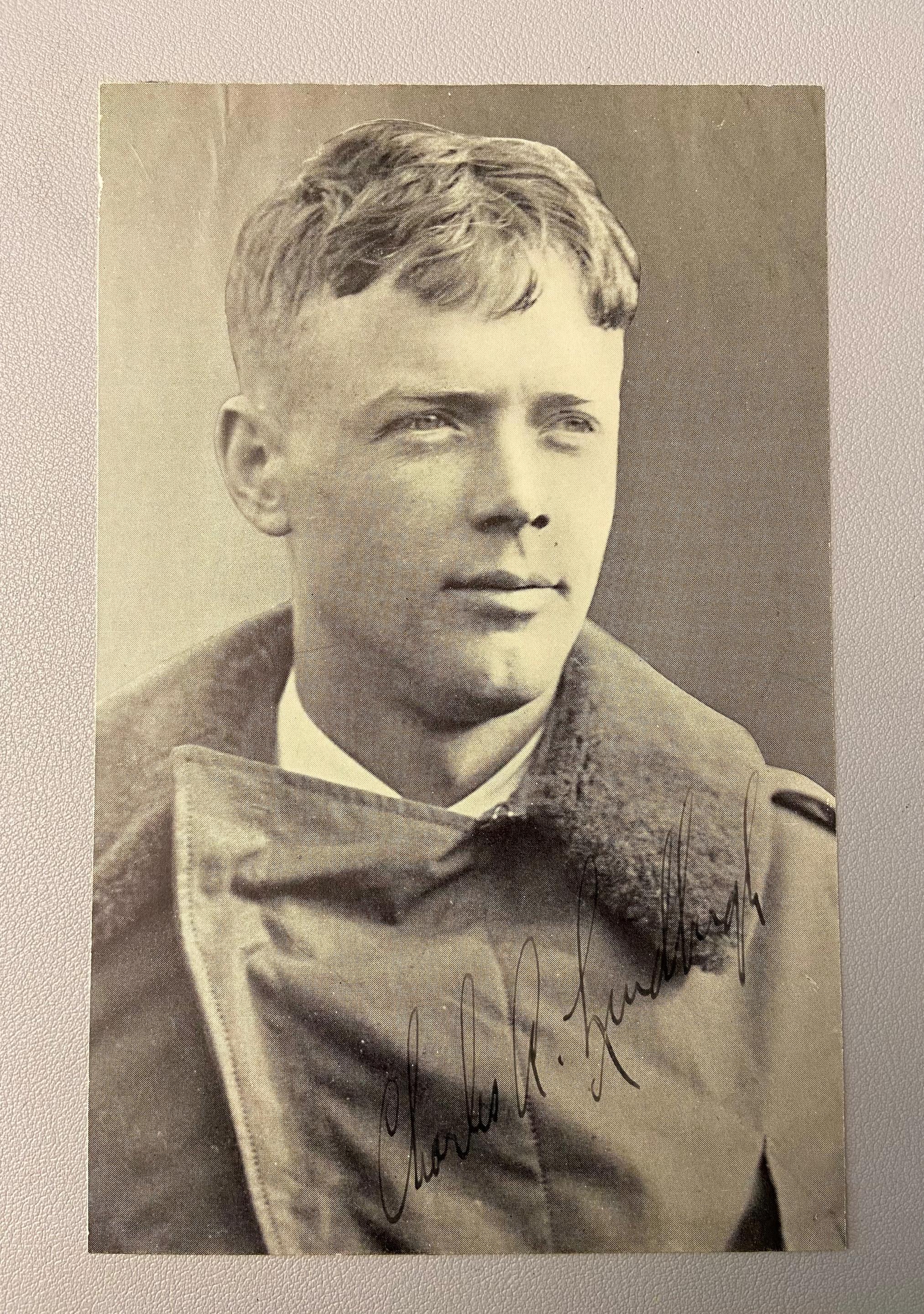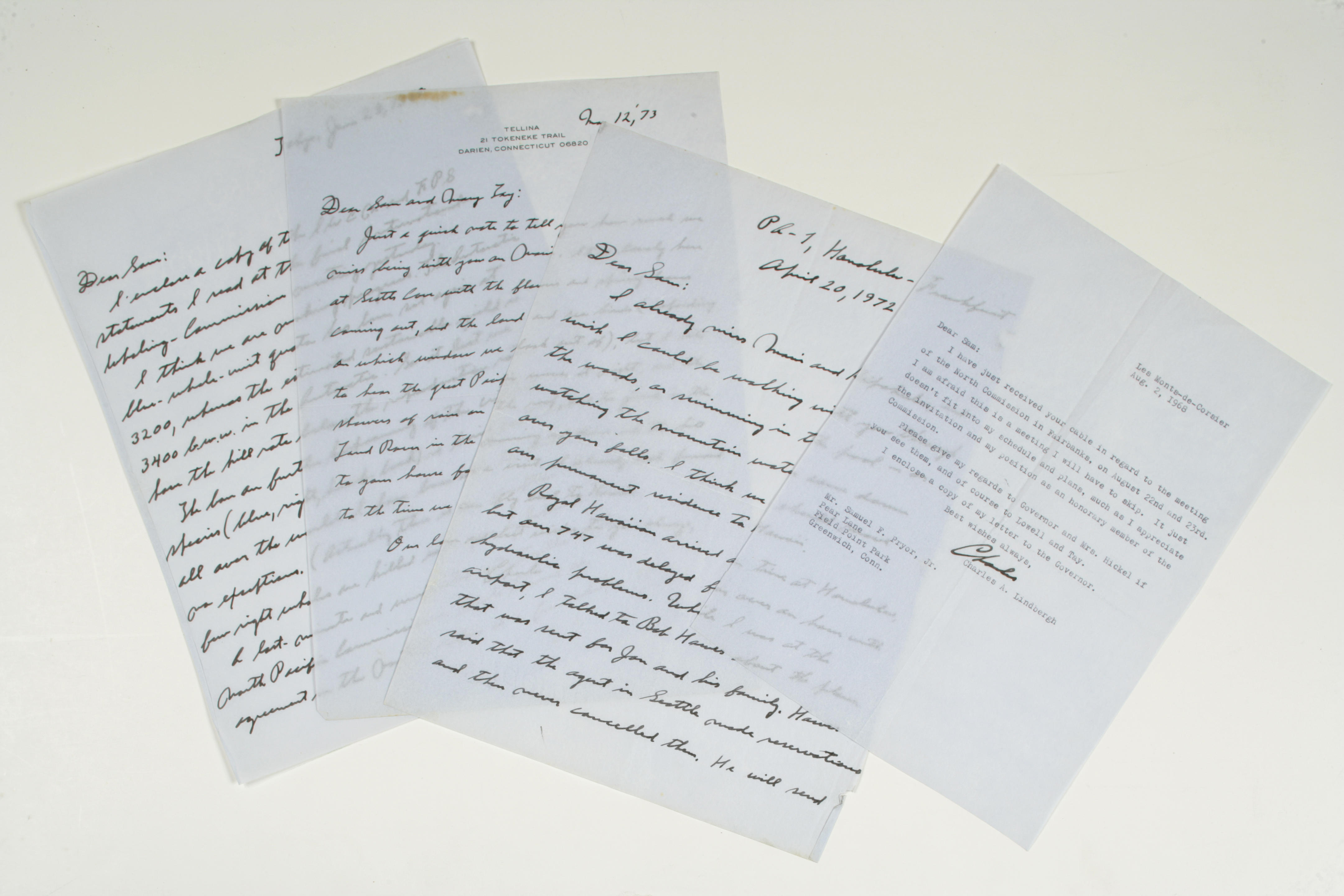LINDBERGH, Charles. A group of 4 documents, (2 signed "Charles Lindbergh" in ink and 2 unsigned), all related to the Wright "Whirlwind" engine, all factory engine test log sheets and routine engine inspection logs, data recorded in pencil, Paterson, New Jersy, 31 March-1 April 1927. Together 6 sheets on 4 leaves, 4 o, 204x280 mm. (81/2 x 11 in.), very good condition. THE ORIGINAL ENGINE TEST SHEETS FOR THE WRIGHT "WHIRLWIND" THAT POWERED THE SPIRIT OF ST. LOUIS FROM NEW YORK TO PARIS, SIGNED BY LINDBERGH A unique selection of documents from the Wright Aeronautical Corporation in Paterson; the factory Log Sheets for Engine Test and the Routine Engine Inspection results for a Wright J5C airplane engine, manufacturer's number 7331, the engine that took Lindbergh on his historic trans-atlantic flight on May 22, 1927. The log sheets record with precision the performance of the "Whirlwind" engine, including the rpms of the fan and the oil, water and air temperatures over a series of two three-hour tests and a last hour "final acceptance test". The Wright J-5C was the civilian version of the R-790, the standard engine used by the Air Corps through the 1920s and 1930s. Most engines of the day were water-cooled and suffered frequent failures, particularly with radiators and gaskets leaking. Clearly, such an engine would be inappropriate for Lindbergh. A solo flight over the Atlantic demanded a simple (no water-cooling appurtenances), reliable and easily maintained engine. And a light one. At 510 lbs. and with a radial air-cooled system, the J-5C fit the requirements for distance flying perfectly. Its new design was so efficient that it could be operated with a lean air/fuel mixture and its steady 20 hp at 1800 rpm kept it the choice for long distance air travel. Lindbergh had originally wanted the Wright-Bellanca WB-2 airplane that Wright had contracted Bellanca to build in order to showcase the J-5C. That plane though perfect for the task, proved too expensive and so Lindbergh turned to the Ryan factory in San Diego to build the Spirit of St. Louis . He kept the J-5C as the engine of choice, standard but for the replacement of 18 manually lubed rocker arms grease fittings with automatic spring and plunger types. The "Whirlwind" ran for over 33 hours continuously, and shortly became the choice for long distance flying, found on routes to Europe, across the Pacific and to the North and South Poles. (4)
LINDBERGH, Charles. A group of 4 documents, (2 signed "Charles Lindbergh" in ink and 2 unsigned), all related to the Wright "Whirlwind" engine, all factory engine test log sheets and routine engine inspection logs, data recorded in pencil, Paterson, New Jersy, 31 March-1 April 1927. Together 6 sheets on 4 leaves, 4 o, 204x280 mm. (81/2 x 11 in.), very good condition. THE ORIGINAL ENGINE TEST SHEETS FOR THE WRIGHT "WHIRLWIND" THAT POWERED THE SPIRIT OF ST. LOUIS FROM NEW YORK TO PARIS, SIGNED BY LINDBERGH A unique selection of documents from the Wright Aeronautical Corporation in Paterson; the factory Log Sheets for Engine Test and the Routine Engine Inspection results for a Wright J5C airplane engine, manufacturer's number 7331, the engine that took Lindbergh on his historic trans-atlantic flight on May 22, 1927. The log sheets record with precision the performance of the "Whirlwind" engine, including the rpms of the fan and the oil, water and air temperatures over a series of two three-hour tests and a last hour "final acceptance test". The Wright J-5C was the civilian version of the R-790, the standard engine used by the Air Corps through the 1920s and 1930s. Most engines of the day were water-cooled and suffered frequent failures, particularly with radiators and gaskets leaking. Clearly, such an engine would be inappropriate for Lindbergh. A solo flight over the Atlantic demanded a simple (no water-cooling appurtenances), reliable and easily maintained engine. And a light one. At 510 lbs. and with a radial air-cooled system, the J-5C fit the requirements for distance flying perfectly. Its new design was so efficient that it could be operated with a lean air/fuel mixture and its steady 20 hp at 1800 rpm kept it the choice for long distance air travel. Lindbergh had originally wanted the Wright-Bellanca WB-2 airplane that Wright had contracted Bellanca to build in order to showcase the J-5C. That plane though perfect for the task, proved too expensive and so Lindbergh turned to the Ryan factory in San Diego to build the Spirit of St. Louis . He kept the J-5C as the engine of choice, standard but for the replacement of 18 manually lubed rocker arms grease fittings with automatic spring and plunger types. The "Whirlwind" ran for over 33 hours continuously, and shortly became the choice for long distance flying, found on routes to Europe, across the Pacific and to the North and South Poles. (4)















Try LotSearch and its premium features for 7 days - without any costs!
Be notified automatically about new items in upcoming auctions.
Create an alert